

![]()
|
See You in September PARTLY BECAUSE CM IS HAVING some staff changes (more on that later), we're going on hiatus until the beginning of September. Of course, because it's summer, a lot of our regular readers aren't around anyway. (Though if you're reading this you are around, and -- and I mean this -- you're one of our favourites. But we're still taking a summer break.)
When I say staff changes, I mostly mean that this is my last day at CM. On Monday, I 'll be starting work as an instructor in the new media program at Red River Community College here in Winnipeg. Someone else will at this e-mail address when CM comes back in September.
To all of you -- readers, reviewers, the CM board, and of course Executive Assistant Peter Tittenberger, who started the magazine with me -- thanks. -- Duncan Thornton |
Book Reviews
 Atom Bomb. Atom Bomb.
Features
|
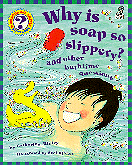
|
Why Is Soap So Slippery?
Do the Doors Open by Magic?
Catherine Ripley. Illustrated by Scot Ritchie.
Preschool - Grade 4 / Ages 3 - 9.
* * * /4 (Soap)
|
excerpt:
Animals don't have bathtubs - so how do they stay clean? All sorts of ways. Believe it or not, zebras roll around in dirt to get clean! It's old skin and bugs they need to clean off. Chimps have a friend pick out the bugs and dirt from their fur, while cats use their tongues to lick themselves clean. Rhinos depend on the help of a special bird -- the bird gets to have a meal of the pesky bugs it finds on the rhino's hide. And elephants shower or bathe in dust, or in water -- without the soap!
 THESE TITLES ARE THE FIRST TWO in a new series from Owl called ``Question and Answer Storybooks." Aimed at inquisitive preschoolers, they combine wordless picture books with introductory science lessons.
THESE TITLES ARE THE FIRST TWO in a new series from Owl called ``Question and Answer Storybooks." Aimed at inquisitive preschoolers, they combine wordless picture books with introductory science lessons.
Why is Soap So Slippery? deals with such bath related questions as why some shampoos sting my eyes, how do towels dry overnight and why fingers wrinkle in the tub. The description of where toilet water travels is easy to understand. A cutaway diagram shows city house pipes connecting to other pipes that lead to a water treatment plant.
Although these may be common questions, some of the answers will be hard to grasp without background knowledge of other scientific principles. For example:

Why is soap so slippery? . . . Like all things, soap is made up of millions of molecules -- tiny pieces so small you can't see them without a microscope. When soap gets wet, water molecules free up the soap molecules so that they can slip and slide around. They slip easily onto your skin, join with the dirt, and slide the dirt right off your body, leaving you clean as a whistle.This may leave adults trying to explain molecular structures, with no assistance from the text.
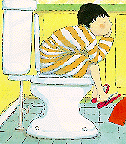
The answer to why we brush our teeth is not for the faint-of-heart:
Inside your mouth are tiny living things called bacteria. When you don't brush, food sticks to your teeth, and the bacteria eat the sugars in it. As they do, they let out waste that's full of acid strong enough to melt the hard outer coating of your teeth. Then, uh oh, the acid makes holes! By brushing your teeth, you get rid of the sugars that the bacteria like to eat.
Each answer will of course lead to more questions -- which isn't necessarily good or bad. As towels dry ``the invisible water vapour floats into the air and away from the towel, until it is dry." If your child asks where the water vapour in the air goes next . . . hopefully you'll recall the information from your past science lessons or be willing to research the answer.
Outside the text is a rather simple storyline showing an Asian father bathing his preschooler. The routine includes brushing his teeth, going to the toilet, bathing, drawing on the steamy mirror then leaving so his big sister can have a turn. These pictures are charming and despite the location, we never actually see the child naked.
Recommended
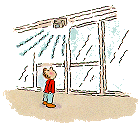 DO THE DOORS OPEN BY MAGIC? successfully answers eleven questions. ``Where do apples come from in the Winter?" has a great answer about putting apples to sleep in the fall in a room without light, warmth or oxygen. ``Months later, when workers took the apples out of the rooms to send to the store, they woke up fresh and crunchy." You learn something new everyday!
DO THE DOORS OPEN BY MAGIC? successfully answers eleven questions. ``Where do apples come from in the Winter?" has a great answer about putting apples to sleep in the fall in a room without light, warmth or oxygen. ``Months later, when workers took the apples out of the rooms to send to the store, they woke up fresh and crunchy." You learn something new everyday!
In answer to ``What's behind the big doors?" we get a simplified overhead shot of the store layout. Doors works much better than Soap. The answers are fun and factual without as many red herrings. The mostly wordless picture book part is also more amusing.

We follow a black mother through the supermarket with her baby and cart-pushing preschooler.Although the youngest upsets a stacked display by removing a can near the bottom, he's the only one who remembers the milk. Other shoppers include a mix of races and ages, as well as a trendy young woman with metal crutches leaving her car in the handicapped stall. Elvis can be spotted in the produce aisle.
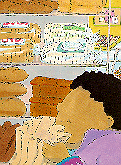
The illustrations for both books are absolutely delightful. Simple and bright watercolour work with lots of amusing details, each perfectly captures a loving family. Attentive readers may notice the Asian father and son neighbours from Soap, as the shoppers are leaving their house.
Supposedly these books are targeted at ages three and up, but the lower end of the range may get lost or bored with the scientific slant of the text. This book could ``grow" with them though, working as wordless book at first, while they invent the story. As questions arise, and/or when they're older, the answers will be of more interest. However, the picture book format, simple storyline and the age of their characters will probably be an obstacle for kids over age nine.
Nevertheless, with clean interesting text, and fun artwork,
both titles are worthwhile purchases for home or school use. Do the Doors Open . . .is especially good.
Highly Recommended

A.Edwardsson works at a branch of the Winnipeg Public Library where she is in charge of the Children's department. She has a Bachelor of Education degree, Child Care Worker III certification and is a member of the Manitoba branch of the Canadian Authors Association.

|
Atom Bomb.
Tom Seddon.
Grades 7 - 9 / Ages 12 - 15.
* * /4
|
excerpt:
At precisely 8:15:17 A.M. Hiroshima time, ``Little Boy" tumbled out of Enola Gay's bomb bay. Tibbets threw the plane into a steep diving turn, in order to escape. After 45 seconds the flash came. More than the momentary blinding light, Tibbets remembered feeling a distinct taste of lead on his tongue. Apparently, the radiation from the bomb's burst struck the fillings of his teeth and caused a chemical reaction . . .Already a giant purple-streaked mushroom cloud had risen 3 miles (5 kilometers) higher than the 6-mile (10-kilometers) altitude of the plane and was still boiling upward. Hiroshima had disappeared under a thick, churning foam of flames and smoke as a hurricane of fire ravaged the city. Shock and horror swept over the crew.
Co-pilot Richard Lewis exclaimed,``My God, what have we done?"
TOM SEDDON CALLS ATOM BOMB a ``picture album." The ``album" is meant to tell three stories: the great scientific quest to understand the puzzle of radioactivity, the Manhattan Project's effort to control and use the power of nuclear fission to win World War II, and the beginnings of anti-nuclear sentiments.
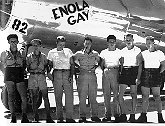
Unfortunately, like many picture albums, Seddon's is of interest only to the person who put it together. The ``album" has lots of uninspiring pictures of dead physicists. Henri Becquerel is wearing a uniform and a sword; Marie and Pierre Curie are standing by their bicycles; James Chadwick, Otto Frisch, and Neils Bohr are not doing much; but Enrico Fermi, Otto Hahn, and Fredric Joliot-Curie are doing some non-specific science stuff. Robert Oppenheimer looks bored, but in what is probably the best of the dead physicists' pictures, James Conant and Vannevar Bush look very drunk after the Trinity nuclear test.
The nuclear spy and physicist Klaus Fuchs, who gave the atomic secret to the Soviets, has two identical photos, except that one is a negative image (I suppose that's because we see through him now). Seddon uses this negative image juxtaposition far too often in his ``picture album." He even includes as part of a picture-in-picture view of the Knoxville, Tennessee research complex and the ``Little Boy" nuclear bomb. Once was enough; more is cheap theatrics!

Some of the images of the nuclear destruction of Hiroshima and Nagasaki are tragically evocative. But again Seddon uses theatrics for no real purpose. He turns what could have been edifying images into exploitative cant. And repeatedly using of negative images does little but cheapen and distort the tragic quality of the original pictures.
Seddon's short text does tell the stories he set out to tell, but much of the text is written in a lurid, staccato style that seems meant to titillate rather than educate. The poor attempts at melodramatic flourish do little for the reader.
Unfortunately, many librarians will buy this book based the publisher's description of its merits. They will be disappointed in thin poorly crafted ``picture album" cum book.
Not recommended
Ian Stewart works at Lord Nelson School in Winnipeg and at the University of Winnipeg library.
![]()
|
Executive Assistant Peter Tittenberger  e-mail: cm@mts.net
e-mail: cm@mts.net
|
 majordomo@mbnet.mb.ca
majordomo@mbnet.mb.ca
Postal address:
CM
100 Arthur Street, Suite 208
Winnipeg, MB R3B 1H3
![]()
Copyright © 1996 the Manitoba Library Association.
Reproduction for personal use is permitted only if this copyright notice
is maintained. Any other reproduction is prohibited without
permission.
Published by
The Manitoba Library Association
ISSN 1201-9364
![]()
WELCOME | BOOK REVIEWS BY AUTHOR | BOOK REVIEWS BY TITLE
AUDIO/VIDEO/CD-ROM REVIEWS | VOLUME II INDEX | SEARCH